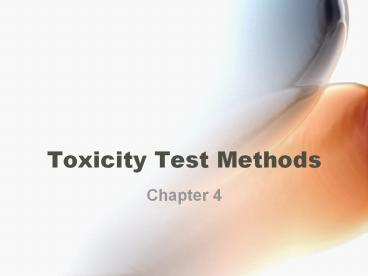Toxicity Test Methods - PowerPoint PPT Presentation
1 / 22
Title:
Toxicity Test Methods
Description:
Toxicity Test Methods Chapter 4 Introduction Working knowledge of standard test methods very important in understanding the field of environmental toxicology Both ... – PowerPoint PPT presentation
Number of Views:150
Avg rating:3.0/5.0
Title: Toxicity Test Methods
1
Toxicity Test Methods
- Chapter 4
2
Introduction
- Working knowledge of standard test methods very
important in understanding the field of
environmental toxicology - Both strengths and weaknesses needed to interpret
test results - Methods were mostly developed in the 80s with
some modifications since then - Most old tests have not been replaced with new
tests but rather have been tweaked over the
years
3
Overview
- Toxicity tests can range from cell cultures to
ecosystem function - Most tests fall under two general classifications
- Single-species
- Relatively cheaper, shorter, low ecological
realism - Multi-species
- Tend to be longer, more expensive and have higher
ecological realisms
4
Single species toxicity testing
- Daphnia 45-h Acute Toxicity Test
- Most widely used test for evaluating toxicity of
water - Three primary species
- Daphnia magna general testing
- Ceriodaphnia dubia chronic testing over an
acute time period - Daphnia pulex evaluation of stormflow toxicity
- All are easy to culture when published guidelines
are followed but some differences in testing
procedure - Note algal tests are most likely to show
hormesis effect
5
D. magna vs. C. dubia
6
Ceriodaphnia dubia toxicity test
7
Daphnia magna toxicity test
8
Single species toxicity testing (cont)
- Algal 96-h growth toxicity test
- Examines toxicity to freshwater and marine algae
- Algae are extremely important because they
generate most of the primary productivity in
aquatic and marine sytems ? effects on algae can
have high impact at higher trophic levels in
ecosystem
9
Microalgae 96-h toxicity test
10
Algal toxicity test
11
Single species toxicity testing (cont)
- Acute toxicity tests with aquatic organisms
- Multiple tests using a variety of fish,
amphibians and macroinvertebrates - Endpoint is either death or immobilization
- More difficult to culture or obtain as test
organisms so often use animals collected from the
wild or available commercially as bait - Test organisms may need to be acclimated to
laboratory conditions - More variability in response because of increased
heterogeneity of gene pool - Locally collected organisms may provide better
indication of effect of xenobiotics on local
ecosystems - See table 4.5 (p. 80-82) for specific test
organisms and test conditions
12
Fathead minnow culture
13
Single species toxicity testing (cont)
- Terrestrial vertebrate toxicity test
- Mammals, birds
- Toxicant usually introduced in food (gelatin
capsule or gastric lavage) - Mammals ? surrogate for human health effects
- Birds ? effect of pesticides on non-target
species - Both animal groups are usually tested for 90 days
- Endpoint death, test may include urinalysis,
hematology, necropsy
14
Small mammals collected from the wild may not be
suitable for toxicity testing
15
Beware of using large wild rats!
16
Single species toxicity testing (cont)
- Frog Embryo Teratogenesis Assay Xenopus (FETAX)
- One of few standardized amphibian-based toxicity
tests - Designed to test teratogenicity of chemicals or
effluent using the African Clawed frog as a
surrogate for humans - Good correlation between known human teratogens
and FETAX results
17
Xenopus life cycle
18
Multi-species toxicity test
- Artificially contained communities
- Must contain two or more interacting species
- Trying to simulate environmental realism but
often want to reduce heterogeneity in test
conditions - Wide range of size and complexity in
multi-species test protocols
19
Microcosms and Mesocosms
- Microcosms
- Small (can usually be picked up)
- Assembled to include specific components
- Highly defined artificial ecosystem
- Easy, cheap to replicate
- Moderate level of environmental realism
- Mesocosms
- Larger (kiddie wading pool to 3 acre ponds)
- May include volunteer components so system is
less defined - Expensive, hard to maintain
- High level of environmental realism
20
Microcosms
21
Mesocosms
22
Uses of microcosms and mesocosms
- 1 - Test for ecosystem level effects of
pesticides (FIFRA microcosms) - Effects of oil spills on marine ecosystem
- Effect of draining aquaculture ponds into
adjacent stream - Any ecosystem level test































